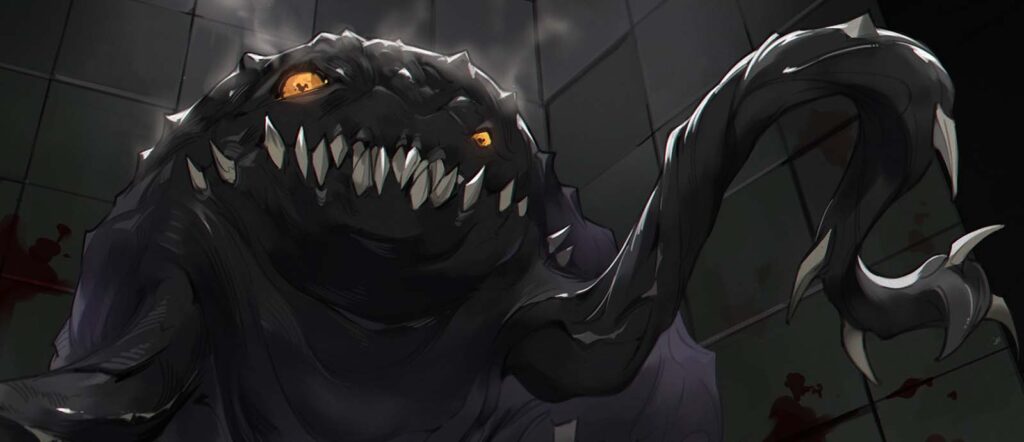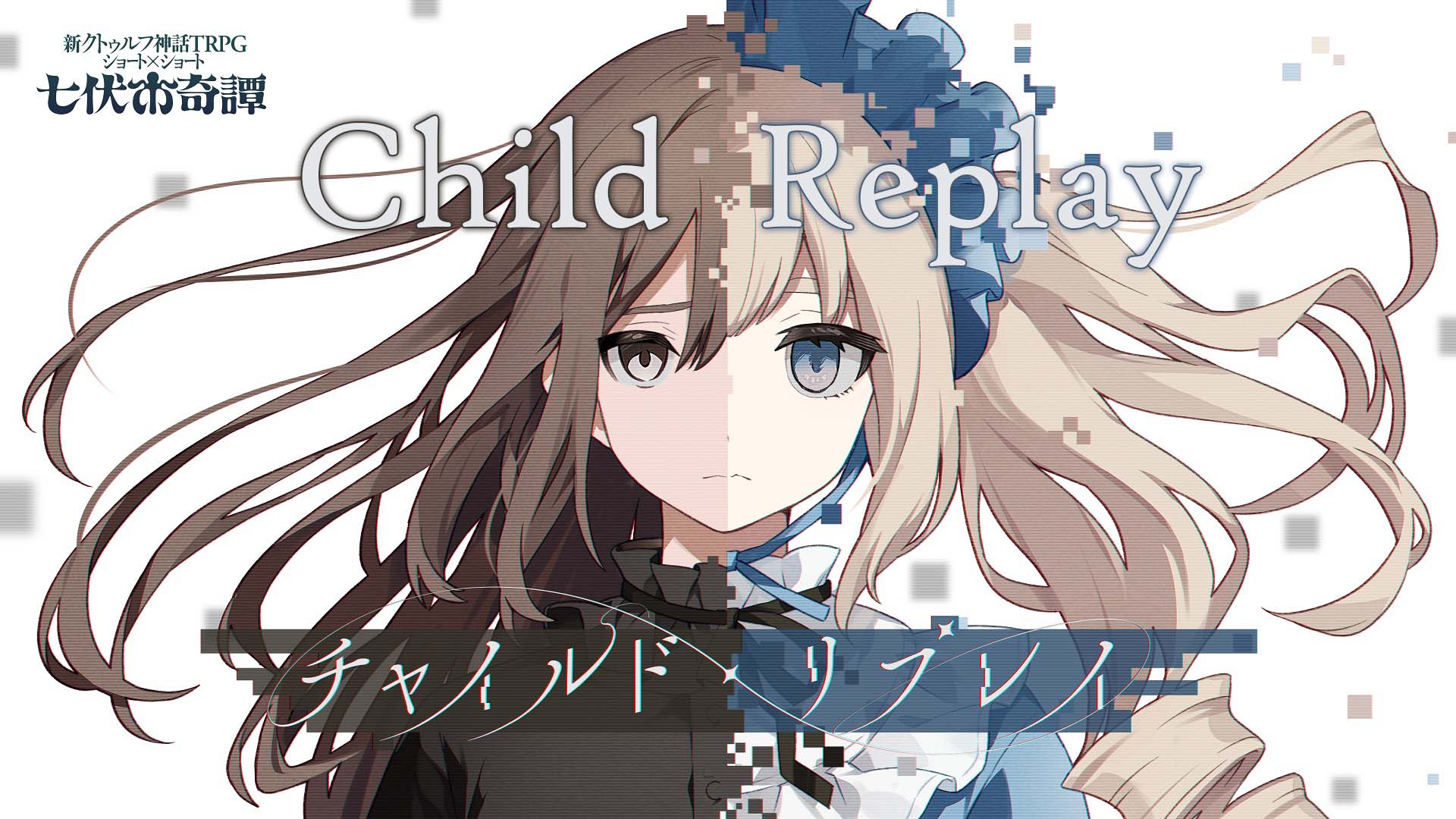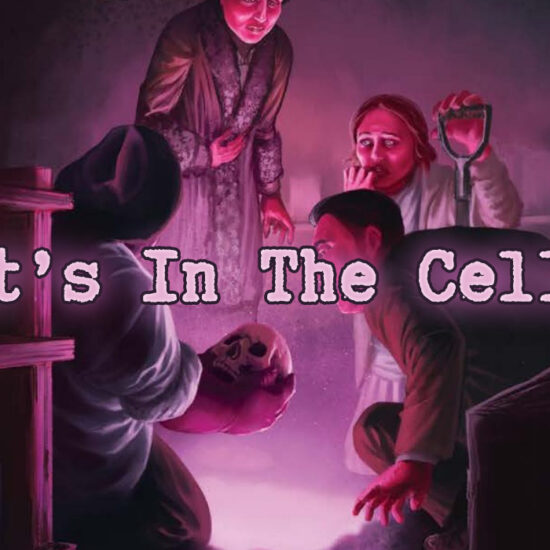The following is a review of the Japanese Call of Cthulhu scenario, Child Replay (チャイルド・リプレイ), written by horror-videogame-developer Sanada Makoto and Studio Arkham’s Satsukino Uso, published online by KADOKAWA as part of the ‘Tales of Nanafushi’ project.
In Short: A tightly set scenario with an unsettling but touching atmosphere and background, and made into something special thanks to an extremely well used ‘gimmick,’ all of which have shot this up into one of my favourite one-shot/convention scenarios.
Spoiler-lite for Players and Keepers
As part of the ‘Tales of Nanafushi’ project, Child Replay is designed as a short, quick to pick up and quick to run scenario. Like many of the scenarios in the ‘Tales’ series, it is cowritten by a Studio Arkham member (the main writing group behind the Japanese Call of Cthulhu publications) and a horror-related creative from outside the TTRPG industry; in this case, Sanada Makoto, creator of the Angel of Death videogame/manga/novel/anime mixed-media series. I haven’t interacted at all with the Angel of Death series, nor read or ran any scenarios by Satsukino, but after Child Replay, I am keen on trying Sanada’s games and following up on Satsukino’s other Cthulhu work.
Not having any experience with either creator’s previous work, it’s hard to tell who to give credit to for the different aspects of the scenario, but it’s at least clear they worked together well. The backstory and NPCs, location, atmosphere, and main ‘gimmick’ all gel together perfectly (‘gimmick’ is probably a bit of a misnomer and is too negative a word, you could call it a ‘central mechanic’ if you want to be wordier). I imagine the physical layout of the scenario location, mechanics, and ‘gameplay’ for lack of a better term, are mostly the work of Satsukino, while the theme and ‘story’ come largely from Sanada, but in whatever case, everything works together very well.
It is very hard to say much about the scenario without spoilers besides some general ‘vibe’ words. Atmospheric, claustrophobic, alternatively nostalgic and oppressive, etc. etc. Some of its impact is tied to Japanese pop culture, so without changing the setting some of that feeling might be lost, but at the same time the scenario could be fairly easily transported to any setting desirable. In any event, despite the scenario’s short length and lack of pregenerated investigators (as always…), it has a strong foundation for players to launch into great roleplaying from.
There are some awkward bits that could be righted, mostly matters of taste, though the central ‘gimmick’ mechanic could be simplified a tad. While not as directed as many of its peers, Child Replay does still have some significantly scripted sections that Keepers could shorten. The scenario is fairly freeform in its limited setting, though, without too many rails forcing the players between specific scenes.

The scenario text covers a 15 page, full-colour pdf with a map, illustrations, handouts, and stat blocks. It is well laid out, as with most official scenarios, and has plenty of boxed text and bullet points to break up the main paragraphs, though there are some longer chunks of text, mostly in places with read-aloud sections. Also included are separate image files for all the illustrations in the text, as well as extra images for VTT play, and stat blocks ready for import into Cocofolia (the VTT of choice for the Japanese CoC community). The scenario suggests a 2-hour run time, but if your players are halfway into actual roleplaying, you can easily double that.
It’s hard to say any more without excessive spoilers, so I’ll just say that ‘Child Replay’ has shot up to standing alongside ‘Three Requests’ as one of my favourite short, convention-slot length Japanese scenarios. While not as player-problem-solving led as ‘Three Requests’, ‘Child Replay’ allows for more investigator roleplay drama while still having the sort of restricted location exploration I love. Child Replay is only in Japanese, but is available digitally on TALTO and Booth.

The core ‘gimmick’ of Child Replay has the investigators, starting as 20-somethings or older, transforming into elementary-school age versions of themselves after the first act. Mechanically this is just done by reducing the investigators SIZE (through a somewhat clumsy equation that I simplified to ‘halve SIZ and add 1d10’) and adjusting derived stats accordingly, but the scenario plays with memory and nostalgia from start to finish through some fun themes and extra sanity mechanics.
Though the scenario does not come with pregenerated investigators, the opening scene has the characters, old friends since elementary school who are meeting at a reunion drinking party in their home town, playing a ‘memory die’ game. They roll a die, then answer two related questions that apply to their childhood and current situation. For example, what they fear most now and what scared them as a child, or what their current workplace/education relationships are like and who their best childhood friend was. These answers help quickly round out the player characters, even if they were quickly rolled up for a convention one-shot, and the answers come back later in the scenario to haunt the de-aged investigators.
This memory game is pushed on the investigators by an old friend from elementary school. Little do they know, he actually died recently, and they’re talking to an animated doll made out of his flesh. Super weird! This NPC is crucial, as he’s the induction into the meat of the scenario, so if he’s obviously suspicious everything could fall apart. Luckily, he’s easy to make seem like a bit of an awkward loser that just wants to make friends, and CoC tropes make him seem like the classic ‘investigator-acquaintance’ who ropes the party into the mystery. Which he technically is, but also, flesh puppet.
Puppet-friend eventually lures the party to a doll museum, run by an insane dollmaker who is trying to revive his daughter with doll-making and a deal with a spooky Mythos deity, Gol-Goroth. He’s made the daughter-doll by sacrificing a number of people already, but something is off about her, and to truly give her life the deity requires a sacrifice of children. Not wanting to be a weirdo and kill ‘real’ children, the dollmaker wants to go a roundabout way and transform some adults, the unsuspecting investigators, into children, then sacrifice them to the ol’ Gol-Gory.

The bulk of the scenario takes place after the investigators wake up in a strange basement in child form, alongside a little girl (the dollmaker’s revived doll-daughter). The investigators then explore around the spooky rooms in the basement with the doll-daughter, getting to know her while experiencing things that remind them of their childhood, setting off SAN rolls. There are all manner of creepy things to uncover in the basement, including their old friend who plays hide-and-seek with them while his ‘skin’ boils and sloughs off, a room full of ripped apart sacrifices with their flesh being melted into a putty to make dolls, and a little window that peaks into a room with Gol-Goroth sitting on a pedestal, disguised as something beloved from the investigators childhood, and ready to transform into their childhood nightmare if they go through the window.
To escape the basement, the investigators need to convince the doll-daughter she is actually dead (investigators should clue into this through uncovered handouts and the weird things the doll-daughter says), most likely doing so by finding the daughter’s corpse in a freezer behind Gol-Goroth. Once convinced, the doll-daughter wants to end her messed-up existence, for her father’s sake more than her own, and asks for the investigators to bash her head in. Que the father storming in, big fight until the doll-daughter dies, escape from crumbling basement and pursuing slimy monster, drop curtains.
While this sounds a bit linear, it doesn’t feel so in play, and the investigators are free to move around the basement and interact with the doll-daughter however they feel fit, allowing for plenty of chances to mix things up. Some extra ways a Keeper could open up the scenario even more could be to allow an early and nigh-impossible escape attempt (with its danger well-telegraphed, of course), or the doll-daughter not wanting to die if the investigators have been dicks to her.
An early escape attempt would hinge on a weird black chimney-like pillar in the centre of the basement. The scenario text describes the pillar as brittle, but also says the investigators are unable to damage it, requiring the doll-maker to destroy it once his doll-daughter dies. Instead, the investigators could be allowed to destroy it, but it takes a good chunk of damage to do so, and with each chunk broken off the basement rumbles and phases in-and-out of reality while Gol-Goroth screeches and gets ready to burst out of its hidey-hole. Ideally, investigators will realise destroying this with them still in the middle of the basement is a bad idea, but if they go through with it, a Keeper could describe the pocket-dimension falling apart as the deity attacks them, and after a few rounds the doll-maker finally opens up a locked door to save his doll-daughter, allowing any surviving investigators to try to escape – but if they do, they are stuck in their child forms until they grow up again.
Much of my appreciation for the scenario came out of the specific group of players I had (I ran this during the ‘A Weekend With Good Friends 2025’), who all took the nostalgia concept and ran with it. Having players that will make sure their characters’ relationships take front and centre, or if the Keeper prepares investigators with strong relationship hooks, elevates the scenario from at least a neat dungeon crawl to the emotional heights it deserves. As mentioned before, the scenario’s start does a good job at least giving each individual investigator some nostalgic memories to play with, but adding in that grade-school-age connection between the investigators cements the themes and feeds meaty roleplay opportunities. For my run, I made the investigators fairly simple, but gave each of them different, classic childhood relationships with each other. Some were best friends, some envied each other, some made others uncomfortable, some had crushes on each other, etc. They’ve all moved on from each other, but then they’re transformed back into kids, forced through a traumatic experience together, and all the while the doll-daughter asks them about adulthood and the process of growing up. It’s just very sweet stuff amid all the flesh-puddy, dead kids, and shapeshifting monsters.
Of course, if the players want none of that, then the scenario could indeed take its stated 2 hours as they blitz through the basement like the D&D dungeon crawlers they are. And that would be fine, it’s a nice little dungeon, but I can’t help but think it would be missing the point.
Child Replay is available on Booth and TALTO. It is currently only in Japanese, but as a pdf, your machine translator of choice can help get it into a working shape in your preferred language.




